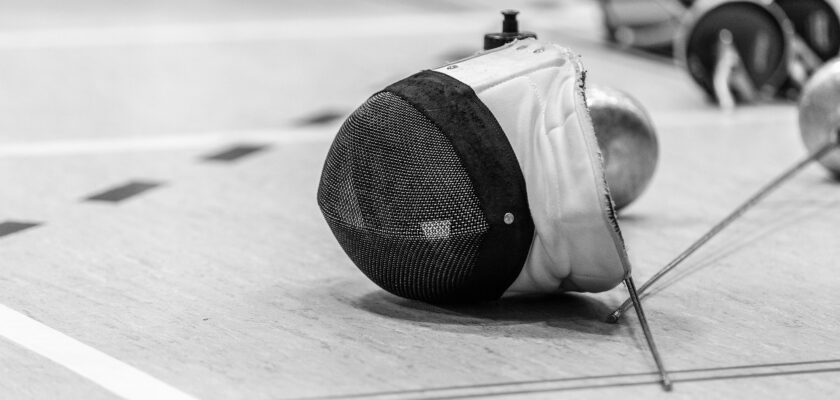Fencing is not as popular a sport as soccer, volleyball, basketball and many others, but it has many fans all over the world, both practitioners and spectators.
The sport has very peculiar characteristics, since the athletes wear uniforms and hold a sword, and it can be a little difficult for everyone to understand how it works. With this in mind, we have created a fencing glossary explaining the main terms used in the activity.
In this fencing glossary we’ve prepared for you, you’ll be able to find out which words are most used during the practice of the sport, understanding their meanings.
With this knowledge, you’ll be able to watch fencing matches much more attentively, because you’ll understand everything that’s going on!
What’s more, learning about fencing will open your mind even more if you want to take up the sport. The sport is very old and has a long history in the world, resulting in many changes, curiosities and new competitions.
Among the terms we’ll cover in the glossary of fencing are blade, offense, track, signal, broom, touche, lunge and many others. Ready to learn more about these sports?
Join our free Whatsapp community and receive daily tips, news and trivia on over 50 sports! Click here to join.
 Check out the fencing glossary!
Check out the fencing glossary!
Fencing glossary: complete list of terms
Check out the full list of terms we’ll be covering in the fencing glossary. Learn about the ostrich, engagement, touche, pass, fleche, lunge, blade and much more!
- Attack
- Ostrich
- Setback
- Disarm
- Dispute
- Engagement
- Stowing
- Fleche
- Guard
- Immobilization
- Blade
- Mask
- Offense
- Stop
- Pass
- Track
- Plastron
- Scoring
- Posture
- Reaction
- Remise
- Riposte
- Salon
- Signal
- Touch
- Technique
- Strip
- Touche
- Broom
Fencing glossary: find out what the sport’s main terms mean
Attack
In fencing, an attack is an action carried out with the intention of touching the opponent.
Ostrich
The ostrich is a defensive position in which the fencer protects his head by bending down and curving his body.
Setback
In fencing, the countermove is a defensive technique in which the fencer makes an attack in response to the opponent’s attack.
Disarming
In fencing, the act of disarming is to remove the opponent’s weapon with a skillful movement.
Contest
A bout is basically a confrontation between two fencers during a fight.
Engagement
In fencing, engagement means the contact of blades between two fencers.
Parry
In fencing, a lunge is an attack made by thrusting the tip of the sword towards the opponent.
Fleche
In fencing, fleche is the act of advancing quickly and making a follow-up attack.
Guard
Guard is a fencing term meaning the basic defensive position adopted by the fencer.
Immobilization
Immobilization is the act of surrendering or neutralizing an opponent’s weapon.
 Fencing glossary: find out the main terms used in the sport
Fencing glossary: find out the main terms used in the sport
Blade
In fencing, the blade is the metal part of the sword used to strike the opponent.
Mask
In fencing, athletes wear a mask, which is basically a piece of protective equipment designed to cover the face while fencing.
Offense
Offense, in fencing, is the part of combat that involves attacks and aggressive actions.
Parade
In fencing, a parry is the name given to the defensive move made to block an opponent’s attack.
Pass
In fencing, a pass is a quick movement made to advance towards the opponent.
Piste
The term piste in fencing is given to the designated combat area where fencers compete.
Plastron
The plastron is basically a piece of protection worn under the jacket to protect the chest.
Scoring
In fencing, scoring is a system of counting points used to determine the winner of a fight.
Stance
In fencing, posture is the position of the body and limbs during combat.
Reaction
In fencing, reaction is a quick response to an opponent’s action.
Remise
Remise, in fencing, means the second immediate attack made after an initial attack has been unsuccessful.
Riposte
The riposte is an immediate counterattack after a successful stop in fencing.
Hall
The hall is where fencing competitions are held.
Signal
In fencing, a signal is a command or gesture used by the referee to start or stop a fight.
Touch
The touch, in fencing, is the point scored by making valid contact with the opponent.
Technique
Technique is basically the set of specific skills and movements used in fencing.
Strip
The strip is a long, narrow strip of fabric used to mark out the combat area on the fencing strip.
Touche
In fencing, the expression touche is used to indicate that a valid touch has been scored.
Broom
Broom is a name given to the quick sweeping motion of the blade in fencing, which is intended to deflect an opponent’s attack.
 Fencing glossary: key terms
Fencing glossary: key terms
Fencing glossary:
- Attack
- Ostrich
- Setback
- Disarm
- Dispute
- Engagement
- Stowing
- Fleche
- Guard
- Immobilization
- Blade
- Mask
- Offense
- Stop
- Pass
- Track
- Plastron
- Scoring
- Posture
- Reaction
- Remise
- Riposte
- Salon
- Signal
- Touch
- Technique
- Strip
- Touche
- Broom
Fencing is a sport that is becoming increasingly popular among many others, mainly because it is different and requires other forms of learning and concentration from its athletes. Now that you know the fencing glossary, you can look up even more information on the subject!
So, if you enjoyed learning about the main terms of fencing in our glossary, it’s time to check out more special content about the sport here on the site.
By exploring the page, you’ll learn much more about fencing and various other sports, be they contact, Olympic, Paralympic and more.
So keep browsing for more lists, rankings, glossaries, news and other special articles about fencing and the sports world in general.
Don’t forget to share it with your friends and leave a comment telling us what else you’d like to read here!




